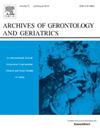Particulate matter, socioeconomic status, and cognitive function among older adults in China
IF 3.5
3区 医学
Q2 GERIATRICS & GERONTOLOGY
引用次数: 0
Abstract
Background
Both air pollution and low socioeconomic status (SES) are associated with worse cognitive function. The extent to which low SES may compound the adverse effect of air pollution on cognitive function remains unclear.
Methods
7,087 older adults aged 65 and above were included from the Chinese Longitudinal Healthy Longevity Survey (CLHLS) and followed up in 4 waves during 2008–2018. Cognitive function was measured repeatedly at each wave using the modified Chinese Mini-Mental State Examination (MMSE). Concentrations of particulate matter (PM1, PM2.5, and PM10) were evaluated using satellite-based spatiotemporal models. SES was measured based on five components and categorized into three levels (low, middle, and high). Generalized estimating equation models were used to estimate the association of PM and SES with cognitive function. Stratified analyses and effect modification by SES levels were further conducted.
Results
Each 10 µg/m3 increase in PM1, PM2.5, and PM10 was associated with a 0.43 (95 % CI: -0.58, -0.27), 0.29 (95% CI: -0.37, -0.20), and 0.17 (95 % CI: -0.22, -0.13) unit decrease in MMSE scores, respectively. Lower SES was associated with worse cognitive function. Significant effect modifications were observed by SES, with the corresponding association of PM exposure being more pronounced among participants with a lower SES (p-interaction = 0.006, 0.001, and 0.006 for PM1, PM2.5, and PM10, respectively).
Conclusions
SES is an important effect modifier, and lower SES may compound the detrimental effect of PM on cognitive health. This finding may have implications for identifying vulnerable populations and targeted interventions against air pollution.
中国老年人的颗粒物、社会经济地位和认知功能
背景:空气污染和低社会经济地位(SES)都与认知功能恶化有关。低SES会在多大程度上加重空气污染对认知功能的不利影响尚不清楚。方法:从中国健康长寿纵向调查(CLHLS)中纳入7087名65岁及以上老年人,并于2008-2018年分4波随访。使用改进的中国简易精神状态检查(MMSE)重复测量每波的认知功能。使用基于卫星的时空模型对颗粒物(PM1、PM2.5和PM10)浓度进行了评估。SES以5个组成部分为基础,分为低、中、高3个等级。采用广义估计方程模型估计PM和SES与认知功能的关系。进一步进行了SES水平的分层分析和效应修正。结果:PM1、PM2.5和PM10每增加10µg/m3, MMSE评分分别下降0.43 (95% CI: -0.58, -0.27)、0.29 (95% CI: -0.37, -0.20)和0.17 (95% CI: -0.22, -0.13)个单位。社会经济地位越低,认知功能越差。社会经济地位对PM1、PM2.5和PM10的影响显著,社会经济地位越低,PM1、PM2.5和PM10的p交互作用分别为0.006、0.001和0.006。结论:社会经济地位是一个重要的效应调节因子,低社会经济地位可能加重PM对认知健康的不利影响。这一发现可能会对识别弱势群体和针对空气污染的有针对性的干预措施产生影响。
本文章由计算机程序翻译,如有差异,请以英文原文为准。
求助全文
约1分钟内获得全文
求助全文
来源期刊
CiteScore
7.30
自引率
5.00%
发文量
198
审稿时长
16 days
期刊介绍:
Archives of Gerontology and Geriatrics provides a medium for the publication of papers from the fields of experimental gerontology and clinical and social geriatrics. The principal aim of the journal is to facilitate the exchange of information between specialists in these three fields of gerontological research. Experimental papers dealing with the basic mechanisms of aging at molecular, cellular, tissue or organ levels will be published.
Clinical papers will be accepted if they provide sufficiently new information or are of fundamental importance for the knowledge of human aging. Purely descriptive clinical papers will be accepted only if the results permit further interpretation. Papers dealing with anti-aging pharmacological preparations in humans are welcome. Papers on the social aspects of geriatrics will be accepted if they are of general interest regarding the epidemiology of aging and the efficiency and working methods of the social organizations for the health care of the elderly.

 求助内容:
求助内容: 应助结果提醒方式:
应助结果提醒方式:


